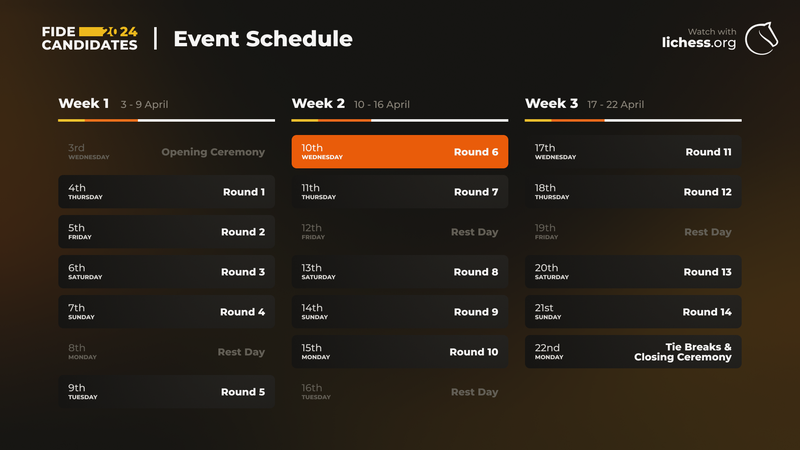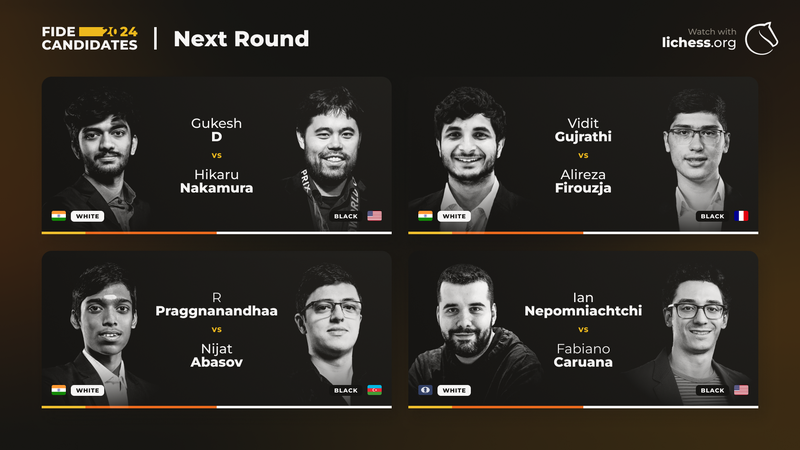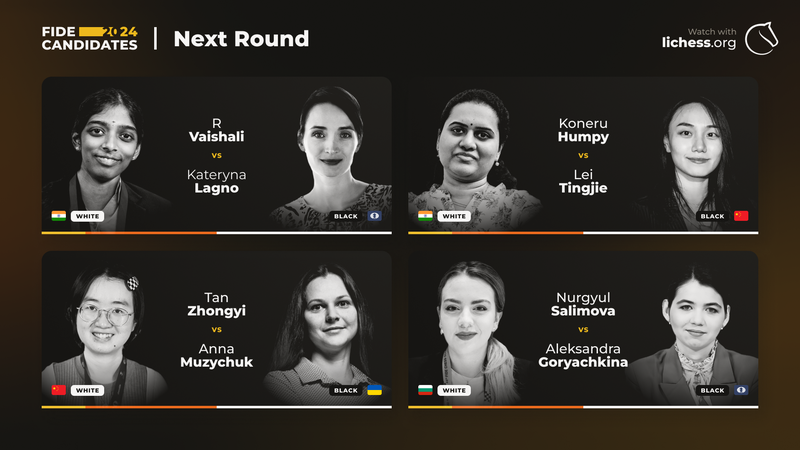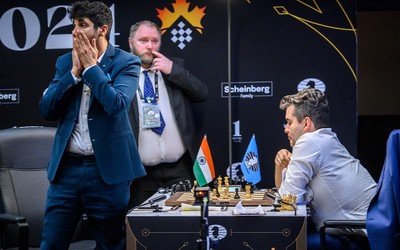
FIDE / Maria Emelianova
Candidates Round 5: Gukesh Catches Nepomniachtchi, Peaceful Day in the Women's
Four potentially decisive games in the Open, two decided games; three potentially decisive games in the Women's, zero decided gamesDid Praggnanandhaa miss a golden opportunity against Nepomniachtchi? Could the same be said for Vidit against Caruana? What about Tan against Salimova? Lagno against Lei? In a way, it depends on who you're asking. If you ask the oracle of Caïssa,Stockfish 16.1, the answer to all those questions is a resounding yes. If you ask our commentators, though, the answer may not be so easy. Chances were missed, that's for sure, but the opportunities missed were not at all clear for human players — there's a pretty good reason why the players who are aiming to become world champions missed them, after all. After all of today's wild swings, the standings in both the open and women's changed little, with the leaderboard in the women's not changing at all and that in the Open changing slightly, propelling Gukesh to shared 1st place with Nepomniachtchi.
As well as broadcasting the live games from the two tournaments, Lichess is providing a live stream for every day of the Candidates. Make sure to tune in to our Twitch or YouTube channels, with streams starting from 14:15 Toronto time (18:15 UTC).
We're also providing daily annotations on some of the games from GM Brandon Jacobson and IM / WGM Padmini Rout.
Schedule

Round Recap
Open Section
Four potentially decisive games. Chess fans are simply being spoiled by this year's Candidates tournament and its enterprising players. Nakamura and Gukesh were today's winners, but there was also quite a good chance for Vidit and Praggnanandhaa to join them.
Praggnanandhaa and his sister, Vaishali, seem to have some really deep ideas against the Petrov. Vaishali sacrificed a knight on f7 against Salimova in round 3, and so too did her brother in round 5 against Nepomniachtchi. Despite one side having an extra piece, the engine evaluated the position as equal. A relatively well-known adage states that "if the engine evaluates a piece-down position (or any position where there's a material sacrifice) as equal, it must be better for the side who sacrificed the piece". That was indeed borne out in this game as Praggnanandhaa, had he played 26. Qe5, could have effectively forced a pawn-up bishop vs. knight position which would have been winning, even objectively. Alas, that was not to be as pieces got traded after 26. Bf5 and a draw was agreed on move 44. GM Brandon Jacobson explains this deeply tactical game:
Gukesh and Abasov saw another Petrov, but, this time, the game was technical rather than sharp. Gukesh had an early advantage due to his better-coordinated pieces, but smooth sailing was difficult in those turbulent Petrov waters. Abasov fought back twice, perhaps thrice, and maybe even four times. Unfortunately for Abasov, who had to contend with defending a queen endgame a pawn down, he blundered under time pressure and resigned on the 87th move.
Nakamura and Firouzja have played countless times against each other in online chess, but not as often in classical chess. Many fans were eagerly awaiting to see what opening both players would choose, and the opening did live up to expectations as the resulting position on move 17 looked fresh, unexplored, and with a lot to play for — for both players. The game was quite rich and complicated, but it did not stray too far off from equality. Thankfully, GM Brandon Jacobson is here to guide us through these hidden complexities. Under the duress of time pressure, Firouzja "blundered" on move 62 in what was a very difficult position that required a lot of calculation.
Caruana's Sicilian against Vidit, who's coming off two back-to-back losses, was a sign that Caruana was ready to fight to try to catch Nepomniachtchi atop the leaderboard. Vidit also did not shy away from complications, castling on the queenside and going for a highly tactical and uncontrolled position. Soon enough, Vidit had a big advantage as Caruana's king looked precariously placed in the center of the board, while Vidit's pieces were lurking around the undefended Black king. Vidit's toughest test came on move 26, where, this time and in comparison to Praggnanandhaa's game, 26. Qe5 allowed Caruana to force a draw after 26...Qa4. Surely this game proved to be a missed opportunity for Vidit, but the winning / almost-winning 26. Kc2 was not only not easy to find, but also very risky to play.
Following these results, our simulations show that Nepomniachtchi's chances have greatly improved, while both Caruana and Gukesh have good chances to win the event as well. Nakamura has a small outside chance to win it all, and, tragically for Abasov, his chances have gone down to 0%.
| Player | Win probability | Most frequent predicted position | Predicted points average |
|---|---|---|---|
| Ian Nepomniachtchi | 37.8% (-2.3%) | 1 (=) | 8.5 (=) |
| Fabiano Caruana | 26.2% (-7.4%) | 1 (=) | 8.2 (-0.2) |
| Gukesh D | 23.8% (+8.9%) | 2 (+1) | 8.2 (+0.4) |
| Hikaru Nakamura | 6.7% (-+4.1%) | 4 (+2) | 7.3 (+0.6) |
| R Praggnanandhaa | 4.4% (-1.1%) | 5 (-1) | 7.1 (+0.1) |
| Vidit Gujrathi | 0.8 (-0.2%) | 6 (+1) | 6.3 (+0.1) |
| Alireza Firouzja | 0.3% (-1.7%) | 7 (-1) | 5.8 (-0.8) |
| Nijat Abasov | 0% (-0.1) | 8 (=) | 4.5 (-0.4) |
Women's Section
Four draws, three exciting games. The less exciting of the bunch, Humpy's game against Goryachkina, was not an insipid draw, either. Lagno was the closest to actually winning her game, but, despite today's chaotic round, peace seemed to be on the agenda.
The tournament leader, Tan Zhongyi — in the sole lead — played against tournament newcomer Nurgyul Salimova. Tan opted for the best by test 1. e4 and Salimova replied with the Caro-Kann, with Tan choosing the Advance variation. Tan outplayed Salimova in the opening, keeping hold of her advanced central e-pawn, but an inaccuracy on move 17 allowed Salimova some counterplay and threats of her own, and Tan never regained the tempo or momentum. From there, Salmova was able to press Tan, although Tan never looked at risk of this tailspinning into anything other than a draw. The draw was eventually realised on move 58 after edgy manoeuvering, in what was a solid result for Salimova. IM / WGM Padmini Rout explains this game in more detail:
Meanwhile, the stalwart Humpy Koneru was facing off against one of the tournament favourites, Aleksandra Goryachkina. Both players opted for well-travelled theory, only diverging from previous played games (per the Lichess masters database) on move 16. The resulting position looked inherently difficult for either player to make significant progress in, and after a cursory effort and investigation by both players, their battle progressed into a skirmish and then into a truce on move 44.
Lei Tingjie, the tournament favourite going into the event, was facing another stalwart — the experienced Kateryna Lagno. Lei opted for the Italian Game, with Lagno going for the Two Knights Defense. Lei eventually went for Benko-esque compensation by sacrificing a pawn on the queenside to gain more central control. That decision was good for Lei, who was better; however, later on in the game, Lei’s position ended up feeling a bit congested and cramped, with Lagno’s pieces exerting solid influence deep into White’s territory. The position looked promising for Lagno, solidified by a mistake from Lei on move 30. Lagno, though, didn’t find the optimal combination, and a blunder by Lagno on move 39 gave Lei a lucky escape and the game ended in a draw on move 44.
The final game of the day was between newcomer Vaishali R and Anna Muzychuk. Vaishali went for a Giuoco Pianissimo, and both players followed established lines. Games exist in the Lichess player database until move 15, although Muychuk’s response was unseen on Lichess servers until today. In a very locked-in pawn structure, Vaishali sacrificed her g4 pawn (with Muzychuk submitting to the unspoken rule of chess that all en passant captures must be accepted), in exchange for greater positional solidity, giving her king access to the centre. With no pawns able to move, rooks unable to break through, and kings unable to make it through enemy lines, a draw was agreed in a position which would inevitably invoke the 50-move rule otherwise. IM / WGM Padmini Rout breaks down this slugfest:
Following these results, our simulations show that Tan has excellent chances to win the event, but one should not count out Goryachkina.Others also have an outside chance of winning the event, with Lagno having a decent chance.
| Player | Win probability | Most frequent predicted position | Predicted points average |
|---|---|---|---|
| Tan Zhongyi | 41.6% (-5.5%) | 1 (=) | 8.4 (-0.2) |
| Aleksandra Goryachkina | 30.7% (+3.1%) | 1 (=) | 8.1 (=) |
| Kateryna Lagno | 13.5% (+1.7%) | 3 (=) | 7.5 (=) |
| Humpy Koneru | 4.3% (+0.1%) | 5 (=) | 6.7 (=) |
| Lei Tingjie | 3.2% (-0.1%) | 6 (=) | 6.6 (=) |
| R Vaishali | 3% (=) | 7 (-1) | 6.5 (=) |
| Anna Muzychuk | 1.9% (+0.1%) | 8 (=) | 6.2 (=) |
| Nurgyul Salimova | 1.9% (+0.7%) | 8 (=) | 6.1 (+0.3) |
Round 6 Preview
In the Open, Gukesh and Nepomniachtchi, the current tournament leaders, will face the two pre-tournament favorites, Nakamura and Caruana, respectively. Vidit and Firouzja, both having lost two games, will play against each other, while Praggnanandhaa will be looking to join the leaders and press as White against Abasov, whose reaction will be quite intriguing: will Abasov play risky chess or take it easy and try to draw as Black?

In the Women’s section, Tan will face Muzychuk, who has had three good or winning positions in her last three games. With today's four draws, not much has changed in the standings, so the same considerations from round 4 remain. Vaishali vs. Lagno and Salimova vs. Goryachkina will be important for the standings, while it will be interesting to see if Lei or Humpy can bounce back.

Make sure to follow the action with us in Round 6!
More blog posts by Lichess

Round 14: Gukesh and Zhongyi are officially the World Championship Challengers
A historic finish to the FIDE Candidates, as 17 year old Indian prodigy becomes the youngest World C…
Candidates Round 13: Gukesh takes the lead, Zhongyi pulls ahead
A massive day for the 17 year old Indian, as his chances to win the Candidates skyrockets, as Zhongy…
Candidates Round 12: Three-ways Tie in Open, Tan Maintains her Lead
Nakamura and Gukesh catch up with Nepomniachtchi in Open, while Tan maintains a safe distance from e…
